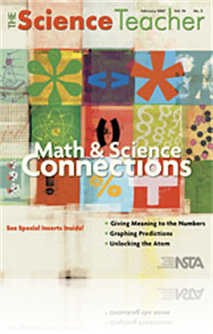All Resources
Journal Article
Science 101: How much overlap is there across science disciplines?
You often will hear that physics, chemistry, biology, and Earth science have a lot in common. In fact, many science curriculum programs stress how these disciplines are integrated and have common concepts and themes. More evidence of this integration...
Journal Article
A local middle school requested that the Water Center of Advanced Materials for Purification of Water With Systems (WaterCAMPWS), a National Science Foundation Science and Technology Center, provide an introduction to pH for their seventh-grade water...
Journal Article
Science Sampler: A (minty) fresh approach to science fair projects
This class activity allows students to quickly “do” a class science fair project in order to see how it’s done. It's also a great way to introduce concepts of controlling variables and testing multiple subjects using an inexpensive breath mint....
Journal Article
Scope on the Skies: Other moons
Nearly 400 years ago, on January 7, 1610, Galileo Galilei turned his new telescope toward the planet Jupiter. In his notes and later in a publication titled Sidereus Nuncius, or The Sidereal Messenger, Galileo described his observations of Jupiter ...
Journal Article
Career of the Month: An interview with Bone Detective Diane France
We have all heard the expression, “eyes are windows to our souls.” Similarly, a forensic anthropologist might say “bones are windows to our lives.” When someone dies and their identity is unknown, skeletal clues can uncover who that person is...
Journal Article
One of the shortcomings in most efforts to integrate art and science is that many of us have a shallow understanding of art, which inevitably leads to shallow connections between art and science. Coloring drawings of planets, building sculptures of v...
Journal Article
Inquiring Minds Do Want to Know
A group of pre-service students assigned to fifth graders with an interest in tornadoes worked over the course of several classes to present a series of lessons that gave students a solid background so they could understand how tornadoes are formed. ...
Journal Article
The ability to engage in argumentation in order to construct, justify, and evaluate scientific explanations is seen by many as an important component of scientific literacy. In order to foster productive argumentation in science classrooms, the autho...
Journal Article
Science and art are both creative ways of understanding the world and representing what we have come to know about it. The concrete, tangible aspects of art often provide a venue for students to convey their grasp of scientific knowledge, such as cre...
Journal Article
The Discovery of <em> Jelly bellicus </em>
Finding an engaging way to teach students the basic principles of natural selection and how evolution is significant to their lives can be a difficult task. As a result, the authors implemented an activity published by Michigan State University (Smit...
Journal Article
In today’s fast-paced, technological world, it is a constant struggle for teachers to find new and exciting ways to challenge and engage our students. The Paint-Stirrer Submarine is a unique and challenging laboratory exercise that keeps the studen...





